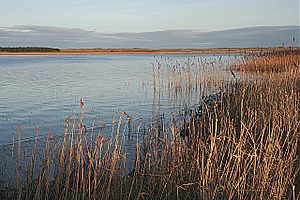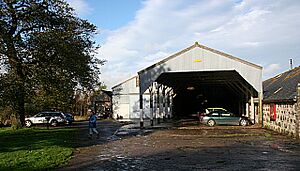Loch of Strathbeg facts for kids
Quick facts for kids Loch Strathbeg |
|
|---|---|

Looking south-east across the loch
|
|
| Location | Aberdeenshire, Scotland |
| Coordinates | 57°37′11″N 1°52′37″W / 57.619806°N 1.876943°W |
| Lake type | loch |
| Basin countries | United Kingdom |
| Designated: | 27 November 1995 |
| Reference #: | 778 |

The Loch of Strathbeg is a special place in Aberdeenshire, Scotland. It's a protected area for wildlife. You can find it near the towns of Rattray and Crimond.
The RSPB looks after the loch. They have built three special hides where visitors can watch birds and other animals. You can get to the loch through Crimond airfield. There's a car park there. The 'Starnafin Centre' is also a great place to learn about the local wildlife.
The RSPB has counted many different types of animals here. They have found over 260 kinds of birds. There are also 280 types of insects and 26 kinds of mammals.
Contents
How Loch Strathbeg Was Formed
The Loch of Strathbeg is quite new in terms of Earth's history. It formed naturally during a huge storm in 1720. Before this, the area was a lagoon connected to the sea. There was a small harbour called Starny Keppie and a village named Rattray.
The storm caused a lot of sand to move. This sand blocked the lagoon from the sea. It also covered the harbour and the village. A historical story says the storm blocked a stream called the "burn of Strathbeg." After that, the stream started flowing directly into the new loch.
Another stream, the "Burn o’ Rattra," also flows into the loch. Maps show that four streams, or "burns" as they are called in Scotland, flow into the loch. There is only one exit point from the loch into the North Sea.
Loch Size and Depth Over Time
In 1854, people estimated the loch was about 2.9 square kilometers (550 Scotch acres). Most of it was in the area of Crimond. At that time, its average depth was about 1.1 meters (3.5 feet). The deepest part was around 2 meters (6.5 feet).
However, the loch's size and depth have changed over time. The same old records say that the nearby beach was very wet. They also noted that the loch had become shallower by about 1.2 meters (4 feet) since 1817. That was only 37 years earlier!
Loch of Strathbeg During World War II
The Loch of Strathbeg played a small role during World War II. In 1943, the German air force, called the Luftwaffe, used the loch area. They dropped supplies for spies in the northern part of the loch.
One time in 1943, the British used a double agent. They set up a fake drop to trick the Germans. A case with a radio, money, and sabotage tools was dropped.
After the war ended in 1945, there was a big minefield on the beach at Rattray. To clear these dangerous land mines, water pumps were used at the Loch of Strathbeg. These pumps provided high-pressure water. This water was used to wash the land mines out of the sand dunes. Sadly, some Royal Engineer soldiers were killed during this dangerous work.
Historical Maps of the Loch
Old maps of the area show how Strathbeg Bay changed into the Loch of Strathbeg. These maps help us understand how the landscape has transformed over hundreds of years.
| Date | What the Map Shows | Link to Map | Map Collection | Map Title | Scale |
|---|---|---|---|---|---|
| 1636–1652 | Shows the loch looking more like a lake than an estuary (a wide river mouth). | zoomed in map; map description on nls.uk | National Library of Scotland | ||
| 1745 | zoomed in image; page on nls.uk | National Library of Scotland | |||
| 1747 | This map shows the estuary, with no loch formed yet. You will need to zoom in to see this clearly. | from DavidRumsey.com | David Rumsey Historical Map Collection | Scotland or N. Britain; by Emanuel Bowen | 1:500,000 |
| 1747-1745 | Shows the loch almost completely closed off from the sea. There is just a small channel leading to the sea from the south side. | from Scran.ac.uk | the Scran database | The Roy Map | 1:36,000 |
| 1790 | This map shows a sand bar starting to form from the north. The loch is beginning to take its current shape. You will need to zoom in to see this clearly. | from DavidRumsey.com | David Rumsey Historical Map Collection | A new and correct map of Scotland or North Britain (Northern section); by Robert Campbell | 1:447,000 |
| 1811 | This map shows the name "Loch Strathbeg" and the outline of the loch. You will need to zoom in to see this clearly. | from DavidRumsey.com | David Rumsey Historical Map Collection | Composite: Scotland; by John Pinkerton | 1:518,000 |
| 1861 | Shows the loch in a shape similar to today. There is a small area of water to the west, coming from the south of the loch. You will need to zoom in to see this clearly. | from DavidRumsey.com | David Rumsey Historical Map Collection | Composite: Scotland; by Alexander Keith Johnston (1804-1871) | 1:633,600 |
| 1883 | The loch is in a shape close to today's, but without the small body of water to the south-west. You will need to zoom in to see this clearly. | from DavidRumsey.com | David Rumsey Historical Map Collection | Scotland 2; by Letts, Son & Co. | 1:760,320 |
| 1922 | Shows the loch in the 20th century, much as it is now. It shows its location compared to Crimond, Lonmay and Rattray. You will need to zoom in to see this clearly. | from DavidRumsey.com | David Rumsey Historical Map Collection | Scotland - northern section; John Bartholomew & Co. | 1:633,600 |
| 1931 | This map shows the loch before World War II. You can see the remains of the Castle of Rattray to the south. The remains of Lonmay Castle are to the north-east. | from NPEmap.org.uk | NPEMap | Ordnance Survey, Sheet 031P | 1:63,360 |
| Current map | Link to the Ordnance Survey website with the current map. | from Bing Maps | Ordnance Survey | Ordnance Survey "Get-a-map" | 1:50,000 |



